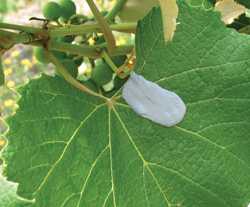Reducing Grape Berry Moth

“We are interested in providing growers with alternative methods of pest control to integrate into their IPM programs,” Isaacs says. “There is increasing pressure for growers to use fewer chemicals or to use tactics that are safer. Because it is very specific to grape berry moth, this pheromone product will not eliminate the need for pesticides, because growers still have to treat for other pests. Rather, mating disruption is one tactic that can be used to reduce the need for spraying insecticides for insect control.”
Conventional methods of grape berry moth control include the application of up to four insecticides, either broad-spectrum insecticides or reduced risk ones such as Delegate (spinetoram, Dow AgroSciences), Intrepid (methoxyfenozide, Dow AgroSciences), and Altacor (rynaxypyr, DuPont Crop Protection). So far, Isaacs says, there is no hard evidence in Michigan that grape berry moth shows resistance to any of the pesticides available, but growers have had difficulty controlling it. Additionally, pheromones have been used successfully in the past using twist ties, but these have faced low adoption due to the high cost of application.
SPLAT Results On GBM
The wax matrix product, called SPLAT-GBM (Specialized Pheromone & Lure Application Technology – Grape Berry Moth), is manufactured by ISCA Technologies. SPLAT is a wax-based formulation containing a small amount of pheromone that attracts grape berry moth males. “When the wax droplets are applied to the grapevine, they gradually release the pheromone over a 10- to 12-week period,” says Isaacs. “This confuses the male, causing him to fly to the wax droplet rather than to a female, resulting in less breeding and ultimately less pest pressure.”
In trials last year, two applications of the wax droplet product to cover the whole season were tested on nine vineyards in southwestern Michigan. SPLAT-GBM was found to produce a 40% to 50% reduction in infestation at vineyard borders, where the goal was 90% to 100%, says Isaacs.
“We are aiming for 90% reduction,” says Isaacs, “but the trial results were encouraging enough to keep working on it. The product requires more research to achieve the desired level of control, and it may require a few years of use to get there,” he says. “We want to make the wax droplet last longer, so it releases more pheromone over a longer period of time, and we are experimenting with different densities of droplets in the vineyard. More pheromone droplets will hopefully be more confusing to grape berry moth males and therefore more effective.”
According to ISCA Technologies, SPLAT has also been developed for codling moth, Oriental fruit moth, pink bollworm, gypsy moth, and Brazilian apple leafroller.
SPLAT Applicator
To expedite application, Isaacs and his team at MSU, including entomologists Paul Jenkins and Keith Mason, developed a mechanical applicator, mounted on the back of an all-terrain vehicle. It included a canister of SPLAT, a bottle of compressed air, hoses, and solenoids, which mounted to a fabricated metal frame that extends over the vineyard rows. The entire setup was created for about $600. With it, the SPLAT-GBM wax can be applied as small (0.8 ml) droplets to vines at up to 10 mph, allowing treatment of 10 acres in an hour, according to Isaacs. “The applicator has significant benefits in speed and cost of application compared with other pheromone application technologies,” Isaacs says.
Three studies were conducted in 2008 to evaluate the efficacy of SPLAT GBM against the grape berry moth. These studies evaluated the rate of application, the timing of application, and the possibility of treating neighboring woodlots. The study found that the optimal rate of application was 1 kilogram per acre, applied prior to moth emergence in the spring. A second application in mid-July can be applied for greater control in areas with a high level of pest population. The MSU team plans to improve the applicator design and will continue their research in the coming season.










